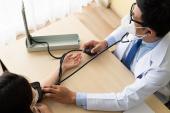USPSTF Reaffirms Earlier Stance on Hypertension Screening in Adults
The Task Force position is bolstered by an evidence report, but editorials raise concerns about racial disparities and masked HTN.

The US Preventive Services Task Force (USPSTF) is sticking by its recommendation that anyone over age 18 be screened for hypertension, and that ambulatory or home-based blood pressure measurements be used to confirm diagnoses prior to initiating treatment.
The final recommendation statement, consistent with the task force’s 2015 position, was published April 27, 2021, in JAMA along with the results of a systematic review looking at additional evidence and several opinion pieces in associated JAMA journals. The reaffirmation clarifies that robust evidence supports the health benefits of hypertension screening, with little evidence of major harms posed by screening in and out of the office.
“We were asking the question, is there compelling evidence that would make us retreat from the recommendation? We didn't expect that we were going to find that evidence, but until you look, you don't really know,” Task Force Vice-Chair Michael Barry, MD (Massachusetts General Hospital, Boston), told TCTMD. “We continue to recommend that adults be screened for hypertension, and as importantly, that initially elevated values in an office setting be confirmed outside the office.”
Evidence Report
Specifically, the Task Force recommends yearly screening for hypertension in adults 40 years or older and for those at high risk, including Black individuals, anyone with high-normal BP, and people who are overweight or obese. Screening every 3 to 5 years is considered appropriate for anyone ages 18 to 39 years who is not at increased risk for hypertension and has had a prior normal reading.
We continue to recommend that adults be screened for hypertension, and as importantly, that initially elevated values in an office setting be confirmed outside the office. Michael Barry
The review of available evidence on benefits and harms of hypertension screening and the accuracy of office and at-home measurements was commissioned by the Task Force and led by Janelle M. Guirguis-Blake, MD (University of Washington, Tacoma). It included 52 studies involving 215,534 people.
Guirguis-Blake and colleagues found that the preponderance of the evidence suggests that office-based screening results in fewer CV-related hospital admissions, although the studies they reviewed showed wide ranges of specificity and sensitivity as well as misdiagnosis when it was the only measure. Office-based screening was not associated with impact on quality of life or adverse psychological outcomes, although a few studies suggested that it could increase absenteeism.
At-home studies showed few harms, with the exception of some patients reporting that wearing a monitor at night interfered with sleep or bruised their arm. Race and ethnicity were not commonly reported in most of the studies reviewed, and participants were predominantly white in those that did report such data. Blake and colleagues also note that while ambulatory BP measurement has been studied more than home-based measurement, there is evidence that the latter may be a valid alternative.
Minorities, Socioeconomics, and Masked Hypertension
A series of editorials published to coincide with the USPSTF document underscore the racial implications.
On the one hand, write Keith C. Ferdinand, MD (Tulane University School of Medicine, New Orleans, LA), and Angela L. Brown, MD (Washington University School of Medicine, St Louis, MO), in JAMA Network Open, undiagnosed and untreated hypertension is a critical issue in racial/ethnic minorities. And yet, recommending a two-stage screening method might further worsen existing disparities. American Heart Association data, they note in their commentary, suggest that a third or more of patients have nonhypertensive office readings that are actually masked hypertension or “white coat” hypertension. That’s been supported, for example, by the Jackson Heart Study.
In the current pandemic environment, Ferdinand and Brown propose, self-measured BP supported through telemedicine could play a bigger role. That said, implementing the kinds of out-of-office BP monitoring supported in the literature, however, remains unrealistic for community health centers that are chronically understaffed, they acknowledged. “Until reimbursement improves, self-measured BP remains a luxury that may contribute to the already persistent, longstanding, and unacceptable disparities in hypertension outcomes, specifically among racial/ethnic minority groups, such as Black and Hispanic/Latinx individuals, and disadvantaged populations.”
In another editorial, this one published in JAMA Cardiology, Yuichiro Yano, MD, PhD (Duke University, Durham, NC), and Donald M. Lloyd-Jones, MD (Northwestern University Feinberg School of Medicine, Chicago, IL), summarize the evidence hinting that the USPSTF guidelines will inevitably leave some patients to fall through the cracks. “Better identification of patients with white coat and masked hypertension using [home BP readings] and [ambulatory readings] may lead not only to closer monitoring of BP levels by patients and clinicians, but also earlier detection of target organ damage or complications and greater adherence to lifestyle recommendations,” they argue.
Echoing those thoughts, a third editorial, by Marwah Abdalla, MD, MPH (Columbia University Irving Medical Center, New York, NY), and colleagues, concludes that efforts to control BP in the population must consider how to achieve success for all people.
“This will require working to address the roots of structural racism and reduce the racial disparities that increase hypertension-related morbidity and mortality for vulnerable populations,” they write. “These changes will take innovation in how care delivery is provided at both the individual and population levels—lessons the healthcare system and society learned are achievable through the response to the COVID-19 pandemic.”
To TCTMD, Barry said the challenges of where to go next to implement hypertension screening equitably are extremely important issues that are welcomed by the Task Force.
“When patients are told to confirm their blood pressure outside of the office, their physician should be helping with that,” he said. “People should be talking with their clinicians about what their best approach is, and what the resources are in the community for measuring blood pressures outside the office if they don't have a blood pressure kit at home.” For example, he added, many pharmacies offer BP measurements free of charge, and there may be other places like fire stations that patients do not know could be a resource for them.
“An extension of getting our message out is helping clinicians really think about how best to do this, and as importantly, where we may be going in the future, and lessons we can learn and grow from as a result of the pandemic,” Barry said.
L.A. McKeown is a Senior Medical Journalist for TCTMD, the Section Editor of CV Team Forum, and Senior Medical…
Read Full BioSources
Krist AH, Davidson KW, Mangione CM, et al; US Preventive Services Task Force. Screening for hypertension in adults: US Preventive Services Task Force reaffirmation recommendation statement. JAMA. 2021;325:1650-1656.
Guirguis-Blake JM, Evans CV, Webber EM, Coppola EL, et al. Screening for hypertension in adults: updated evidence report and systematic review for the US Preventive Services Task Force. JAMA 2021; 325:1657-1669.
Abdalla M, Muntner P, Peterson ED. The USPSTF recommendation on blood pressure screening: making 2021 the transformative year in controlling hypertension. JAMA 2021;325:1618-1619.
Ferdinand KC, Brown AL. Will the 2021 USPSTF hypertension screening recommendation decrease or worsen racial/ethnic disparities in blood pressure control? JAMA Network Open. 2021;4(4):e213718.
Yano Y, Lloyd-Jones DM. USPSTF recommendations for screening for hypertension in adults: it is time to unmask hypertensive risk. JAMA Cardiol. 2021;Epub ahead of print.
Disclosures
- Krist, Barry, Guirguis-Blake, Yano, Lloyd-Jones, and Abdalla report no relevant conflicts of interest.
- Ferdinand reports serving as a consultant for Medtronic, Amgen, and Novartis outside the submitted work.
- Brown reports grants from the National Institutes of Health and Medtronic to her institution outside the submitted work.





Comments